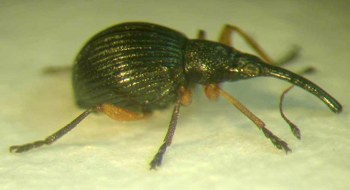Pests
Protapion apricans Hbst. - Clover Seed Weevil (Clover Pear-Shaped Weevil)
Systematic position.
Class Insecta, order Coleoptera, family Apionidae, genus Protapion. Closely related to P. interjectum Desbr., P. schoenherri Boh., P. trifolii L.Biological group.
Pest of clover.Morphology and biology.
Body length without head reaches 2.2-2.7 mm. Rostrum nearly straight; male rostrum somewhat shorter and female rostrum, somewhat longer than length of head and pronotum combined. Male antennae appear slightly behind the middle of rostrum; female antennae appear somewhat before the middle of rostrum. Pronotum oblong, rarely quadrate; disk with large punctures. Elytra widest somewhat behind their middle. Femora edentate. Antennae covered with accumbent hairs. Scape and 1st-3rd funicular segments are yellowish red, 4-7th segments are brown or black. Body and tarsi black. Femora and fore tibiae yellowish red, middle and hind tibiae dark brown or black. Middle and hind trochanters and femora yellowish red. Overwintering beetles gnaw small holes in clover leaves. In spring, the majority of the pest population is female. Oviposition continues over a period of 3 months. Fertility reaches about 100 eggs. Eggs mature in 2-3 weeks. Hatching occurs in 5-9 days. Young larvae burrow into the florets. Larva has 3 instars and devours about 9 ovules. Pupation occurs after 3 weeks on the receptacle. Adults emerge after 1 week.Distribution.
Inhabits most parts of the Palearctic region, except for Tundra territory and deserts; in Finland, it is distributed to a latitude of 68.3°N. In the former USSR, it is widely distributed in the European part, in the Caucasus, in Northern Kazakhstan and in neighboring Russia east to Baikal Lake.Ecology.
Mesophilous meadow species. Everywhere monovoltine. Develops on Trifolium pratense L. and on T. alpestre L., T. medium L., T. repens L., and T. hybridum L. Hibernation of adults begins at the end of August or early autumn; beetles concentrate in the top layer of the soil in clover fields, under leaf debris in forests, and under haystacks (about 6000-11000 specimens per haystack). Some adults diapause for 2 years. The pest population density depends on the activity of larvae and pupae parasite Spintherus linearis Walker (Pteromalidae).Economic significance.
Economic significance of Protapion apricans is noticeable on seed clover in the middle zone of the former USSR. Losses of the seed clover are usually not more than 7-15%, rarely reaching 50%. Control measures include cutting clover during the stage of flowering.Related references:
Dieckmann L. 1977. Contributions to the insect fauna of the GDR: Coleoptera - Curculionidae (Apioninae). Beitrage zur Entomol., Berlin, 27(1): 7-143. (In German)Kryzhanovskii O.L., ed. 1974. The pest insects and ticks of agricultural plants. V. 2. Leningrad: Nauka. 335 p. (In Russian)
Lakhidov A.I., ed. 1976. The system of estimation and forecast of development of pests and diseases of the field cultures in Central-Chernozem region. Voronezh: Tsentral.-chernozem. knizhnoe izd. 136 p. (In Russian)
Shchegolev V.N., ed. 1955. Agricultural Entomology. Leningrad & Moscow: Gos. izd. selskokhoz. lit. 616 p. (In Russian)
Solodovnikova V.S. 1970. Zoogeographical peculiarities of the fauna of the genus Apion Hrbst. (Coleoptera, Apionidae) in the East Ukraine. Entomol. obozr., 49(4): 810-818. (In Russian)
Vasiliev K. 1936. Apions as pests of clover seeds and their control. Moscow: VASKhNIL. 96 p. (In Russian)


